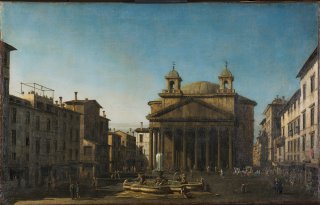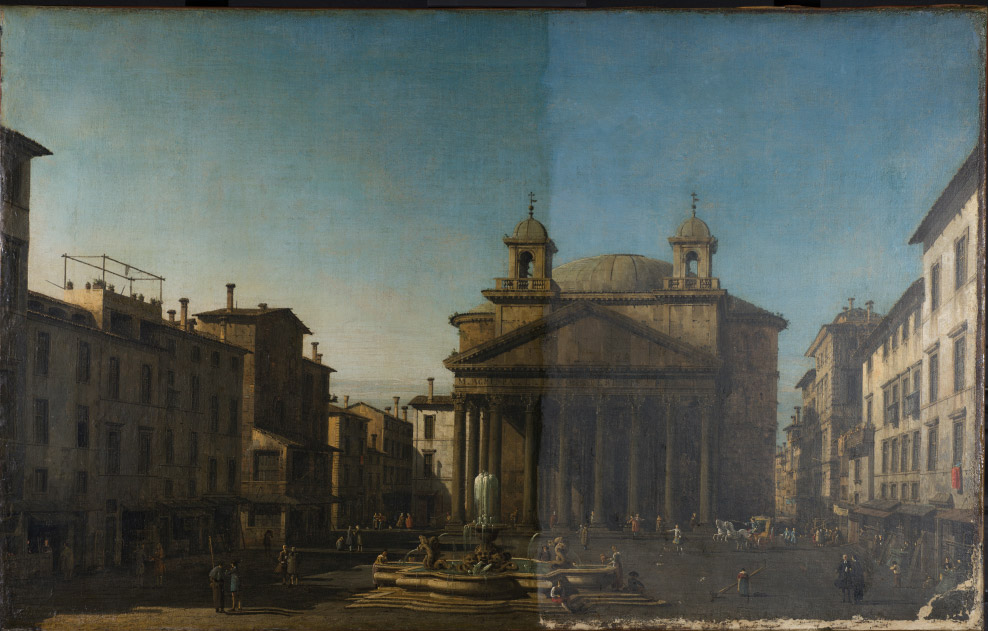
Bernardo Bellotto
The Pantheon
(1720-1780)
Italian c. 1742 24 ½ x 38 ¼ inches Gift of Mr. and Mrs. Elton F. MacDonald 1957.141
Paint the Town, Please
When you travel, do you take pictures of famous buildings? Why do you do it? Before the advent of the modern camera, 18th-century travelers purchased vedute to remember the landmarks they visited. Discover more about the intersection of pictures and places in this sunny painting of Rome.
A Day in the Life
On Tour
The popularity of vedute paintings is tied to the “Grand Tour” phenomenon, a pilgrimage undertaken by Europeans and Americans during the 17th and 18th centuries. The Grand Tour was believed to be essential to a gentleman’s education, allowing men to visit great works of art and architecture in European cities and mingle with cultured society. The journey was most prized, however, as a symbol of status–only the very rich, or those with wealthy patrons, could undertake it. Pilgrims brought back souvenirs and purchased numerous vedute to serve as a visual record of the cities visited, just as travelers today document their own journeys with cameras.
Tools and Techniques
Out of the Box
The vedutisti likely used the camera obscura as an aid to help paint their incredibly detailed works. Sketchbooks owned by Canaletto, Bellotto’s teacher and uncle, include preparatory drawings that seem to have been made with the device. In the 18th century, camera obscuras equipped with lenses and mirrors were made small and portable, allowing artists to trace images of whatever “view” they desired, no matter the location. They then referred to these sketches when painting or etching the final work. Learn how this device works below.
Light bounces off an object, passes through a lens, and then enters a dark chamber, appearing as an inverted, flipped image. A mirror reflects this image onto a piece of paper so that the artist can trace it for reference.

Illustration courtesy of Athena Knisley.
Behind the Scenes
Revealing Details
This painting was recently conserved, undergoing a cleaning that significantly brightened the work and revealed a small, red cardinal that was previously hidden. The cardinal, the red garments of some figures, and red banners in windows pepper the space around the Pantheon. These bursts of red draw the eye across the piazza and back into the city, accentuating the illusion of depth and emphasizing the work’s wealth of detail. You can see how the painting looked half-way through conservation in the photo below.
Quiz
Can you determine where the cardinal is in the composition?
In the sky above the Pantheon.
Perched on the fountain.
Fluttering in the left side of the composition.
In a windowsill on the right side of the composition.

Image of the painting half-way through conservation; the right side has been cleaned.
Look Closer
Just for Kids
Signs & Symbols
Dig Deeper
Arts Intersected
The Sculpture Speaks
Did You Know?
Expert Opinion
Look Around
About the Artist
Picture-Perfect
Bernardo Bellotto was an Italian artist famous for his large, detailed vedute, or “views” depicting cities and other notable sights, a fashionable genre of painting throughout Europe at the time. In 1742, just beginning his independent career as an artist, Bellotto traveled to Rome and rendered the buildings and monuments there, including the Pantheon. He was then commissioned by various royal courts to document their patron cities, ultimately serving the Polish court until his death in 1780. The artist’s legacy continued to live on, however; after WWII, architects used Bellotto’s highly accurate vedute of Warsaw to help rebuild the Polish city, which had been ravaged by German bombs.
Talk Back
Worth A Thousand Likes?
Do you find it important to photograph the places you visit? Why? Do you think that you, your peers, and other members of the public share images of trips and vacations on social media to enhance personal status or prestige, or are other factors involved?

